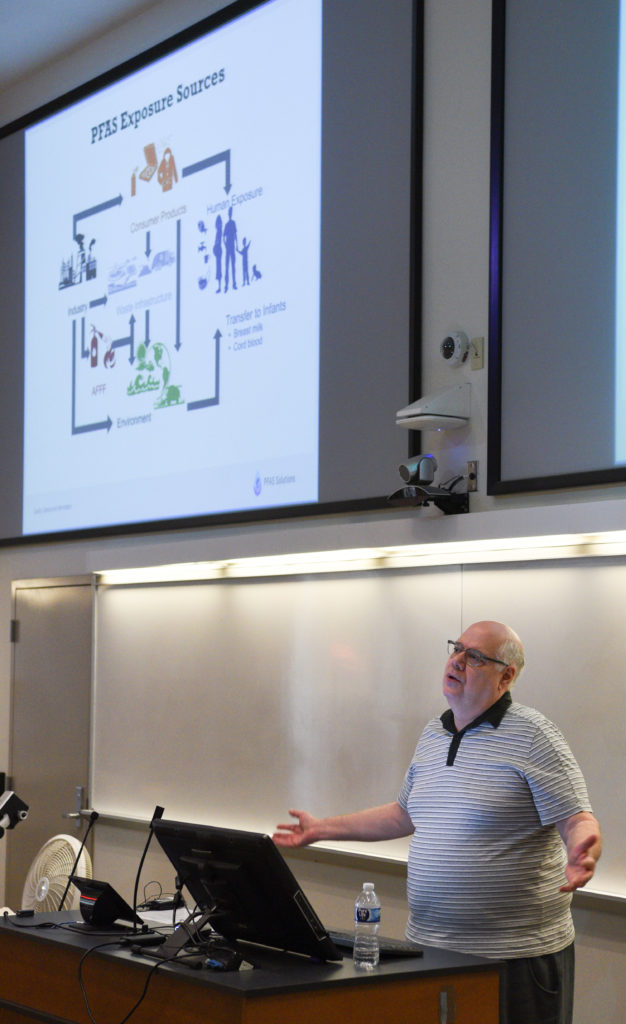
There are 4,000-5,000 known “forever chemicals” that have been found in surface and ground waters, and even in human blood. They get their nickname for their persistence in the environment and poor absorption to most surfaces. Documentaries like “The Devil We Know” and the movie “Dark Waters” have highlighted the potential for health threats to communities.
Dr. Charles Powley, (at right) chief scientist at the Center for PFAS Solutions in New Castle, Delaware, focused on the history of, challenges in moving away from and difficulties associated with testing and containment of these compounds. Powley also discussed what lies ahead in terms of attempting to regulate PFAS compounds. The April 19 lecture was an installation of the SANS Seminar Series.
Per- and polyfluorinated alkyl substances came about with the invention of Teflon in 1938 by the DuPont Company, followed by Scotchguard in 1952 by 3M and Lightwater Aqueous Film-forming Foam in the early ‘70s by the U.S. Navy with consumer products close behind, Powley said. Today, PFAS are used in aerospace, apparel, construction, chemicals, pharmaceuticals, electronics, energy, health care, firefighting and semiconductors.
“It’s going to be a while before these can be eliminated,” Powley said. “These products have saved a lot of lives on Navy ships as firefighting foam for jet fuel fires, for example.”
As to why they are such a concern, Powley said, “They are a triple threat. These (compounds) are persistent, bio-accumulative, mobile toxins.”
Powley addressed the health concerns to humans, animals and the environment. PFAS be passed along to consumers through industry products, leach into water sources through landfills, and make their way into the environment through AFFF and biosolids. Wastewater treatment plants, he said, treat the water with bacteria, for instance, but that process ignores the PFAS compounds.
Pointing to a map, Powley said, “Ten years ago, there was only one dot in West Virginia (referring to an issue related to DuPont), now it’s just about anywhere there is an airport or a Navy base.” Ninety percent of PFAS is unaccounted for, he added.
A method to detect and measure these substances was made available to analysts in 2000 with the commercialization of liquid chromatography-tandem mass spectrometry. Although it could detect levels in water at part per trillion (think one second in 32,000 years) and in soil, sludge, sediment and biota at parts per billion, the analysis proved problematic, he said.

Significant challenges involve contamination from a wide variety of fluorinated surfactants and fluoropolymers that can be introduced at all stages of the analysis, from sampling to instrumental determination. Source identification, one of the primary goals in analysis, in many cases is not possible due to the wide variety of potential origins over the 70-year history of use.
Current regulations, Powley said, have only Environmental Protection Agency health advisory limits. They are geared toward guidance only and are non-enforceable. Federal proposed contamination levels, he said, are coming, possibly by the end of the year. If they are adopted, they would include a minimum reporting level and a “stringent and tough-to-meet” hazard index.
Powley brings over three decades of experience in trace level analysis of PFAS and pesticide residues in the environment while working for the DuPont Company to the discussion. His work has been shared in professional journals and has formed the basis for much of the PFAS analytical work done today. Powley’s current research focuses on the detection and removal from the environment of these chemicals.
Gail Stephens, agricultural communications and media associate, University of Maryland Eastern Shore, School of Agricultural and Natural Sciences, 410-621-3850, gcstephens@umes.edu
Laura Sileo, director of agricultural communications, University of Maryland Eastern Shore, School of Agricultural and Natural Sciences, 410-651-6084, lcsileo@umes.edu.
Photos by Todd Dudek, UMES Ag Communications, University of Maryland Eastern Shore, School of Agricultural and Natural Sciences, tdudek@umes.edu.

